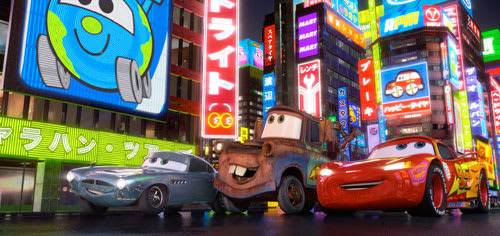Behind The Scenes of 'Cars 2'


That one statement tells you why director John Lasseter felt compelled to follow up Pixar’s hit film “Cars” with a sequel.
It seems that when Lasseter was traveling the world promoting the first film, he was constantly checking out traffic in each city he was in, thinking to himself, “How would these translate into a “Cars” world?”
That global view drives “Cars 2.” It takes Lightning McQueen out of Radiator Springs and puts him into a worldwide race circuit — “We were inspired by the International Race of Champions,” Lasseter said — pitting the “best of the best” on one course. That means pitting Formula One racers, rally cars and more against a heavily modified McQueen.
While a race of that sort might not seem very likely, the Pixar team has created portions of the races in Tokyo, Italy and London that play to each car’s strength: Each course has some off-road sections meant to help rally racers and slow down low-to-the-ground racers, as well as more traditional Grand Prix surfaces and turns.
“We wanted to level the playing field,” said Jay Ward, Cars franchise manager.
Still, F1 vs. NASCAR vs. rally cars? “It’s still a stretch,” Lasseter allowed, “but it’s a movie.”
What helps drive the movie is a spy storyline that involves McQueen’s best friend in Radiator Springs, Mater the tow truck. “Cars 2” is as much about Mater as a fish out of water as it is about racing. And, like in the first film, there’s a deeper meaning that underpins it all.
It has taken about three years to bring “Cars 2” to life, a year shorter than most Pixar productions. Its release this June ties in nicely with Pixar’s 25th anniversary.
Lasseter has plenty of car cred in his background. His father was a parts manager for Chevy dealerships in Southern California, and Lasseter worked at those dealerships, starting as a little kid and continuing through his summers and weekends in his teen years.
“I grew up at the end of the muscle-car era,” he said, noting that he was born in 1957, “arguably one of the greatest years for Chevrolet.”
Currently sitting in his garage are:
- A 1952 Jaguar XK120 black roadster
- A 1964 Messerschmitt
- A 1962 Ford Falcon
The Falcon is the car he towed behind him in the summer of 2000 when he took his family on an RV tour of the country, including some time along Route 66, which strongly influenced the first “Cars” film.
One of the most striking elements of Pixar films — and in the “Cars” movies — is the attention to detail. Many of the cars in the movies are clearly identifiable; others are creations of Pixar. If it’s a real car, though, the Pixar team spared no expense to make sure that they got the details right. “When we use a real car,” Ward said, “we get those details right.”
“We are very adamant about getting it authentic,” Lasseter said. Not just the exhaust note, but also the interior sound as well as the unique sound of the starter, he said. His teams do deep-dive research; they know that they need to “do more research than you’ll ever think you’ll need,” Lasseter said.
It’s not car-geek desire, notes Dave Mullins, a supervising animator for “Cars 2.” “Making it real isn’t the point. Making it believable is the point.”
The reason for that is that most people are familiar with how cars behave in the real world, and it’s easy to create movement that is at odds with what your average driver sees on a daily basis.
“The way cars move is something you inherently are used to seeing,” Lasseter said. “The heavier something is, the more momentum it takes to get it get going. “
Making cars into characters, though, requires a fair amount of tweaking. Pixar needed to rebuild the cars to “make them more expressive,” said Jay Shuster, character art director for the movie.
For most cars, that means reducing the length and the wheelbase, increasing the wheel diameter and shifting proportions to create a believable set of eyes and a mouth. As you might imagine, “it involves a lot math,” Shuster said. “A lot of the work on this film involves a lot of engineering.”
For example, changing NASCAR McQueen into a world racer involved:
- Adding a rear diffuser
- Adding a special spoiler
- New wheels
- Adding headlights for the first time
Although McQueen is modified, he’s still clearly McQueen. “If you change too many colors, too many body shapes,” Ward said, “you lose the character.”
The new logos along McQueen’s side start with his familiar lightning bolt, but they change into surging flame logos, courtesy of car designer Chip Foose, “the King of Flames,” as Shuster put it.
The bottom line, Lasseter said, is delivering cars that will make fans drool.
“Make it so cool,” he said he told his crew, “that you’d want to own this car.”

Former editor-in-chief Patrick Olsen was born and raised in California. He loves pickup trucks and drivers who pay attention.
Featured stories

15-Year Car Loans Aren’t a Thing, But Americans Are Getting More Comfortable With Long Loan Terms

2025 Kia Telluride Review: Rougher Roads Ahead



